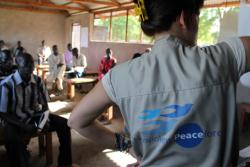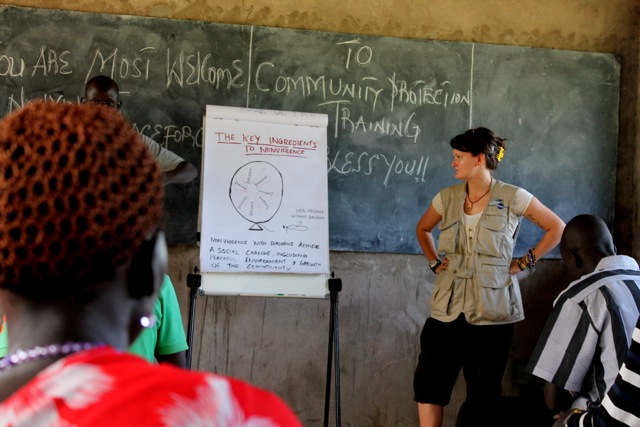Unarmed civilian protection training for military
 Violence has long plagued Lakes State situated in the center of South Sudan. It is the only state in the county without an international border. This means increasing levels of violence since independence have been largely ignored by international agencies. Cross-state cattle raids and inter-and intra-tribal revenge killings continue to threaten the safety and security of civilians; as well the unity of this new nation.
Violence has long plagued Lakes State situated in the center of South Sudan. It is the only state in the county without an international border. This means increasing levels of violence since independence have been largely ignored by international agencies. Cross-state cattle raids and inter-and intra-tribal revenge killings continue to threaten the safety and security of civilians; as well the unity of this new nation.
In response Nonviolent Peaceforce (NP) opened its Lakes State office in the conflict-prone town of Yirol in March 2012. This made it the only civilian protection agency in the area. It became immediately clear upon the team’s arrival that there was a great need unarmed civilian peacekeeping. In the first week alone the team responded to three separate incidents of armed violence. Two of these incidents were in cattle camps and another occurred at a borehole, often a source of conflict due to water scarcity. The latter incident began as an altercation between two women but this erupted into violence involving over 100 armed men from different clans. This created potential for armed hostilities to possibly spill over county and state lines.
Conflict can become rapidly explosive when the new state is weak, has few resources and has little response capacity. In two cases NP provided overnight protective presence for victims from opposing groups receiving treatment in a hospital. The potential for continued violence within the hospital compound was high.
One of biggest challenges for the team was responding to an incident of armed conflict in the community. This situation left three people dead including a child. A number of people were also wounded. NP worked tirelessly with both sides of the conflict, local and state security actors to mitigate the conflict peacefully. This prevented a cycle of revenge and counter-revenge, the form violence often takes in Lakes State. In the weeks that followed a number of people in the town lauded NP’s efforts for having prevented violence, often the first response to conflict. According to a local chief, “because of NP, there was no revenge killing. This was the first time.”
Nonviolent Peaceforce also established the county’s first-ever monthly security coordination meetings. These meetings allow for local and state security actors to discuss security incidents and pool resources for intervention. They were also able to conduct training sessions on civilian protection within conflict-affected communities. Another formidable success was the creation of the state’s first weapons-free zone. South Sudan is awash with weapons because civilians often carry them as they cannot rely on the state for protection. It becomes a catch twenty-two: the more other people carry weapons, the more likely you are to carry one for protection. To alleviate this problem NP came up with the idea of asking everyone in the community not to carry weapons.
 In September NP received the green light from the county commissioner to move forward with this proposal. The NP team then brought together a delegation of chiefs and cattle camp leaders to discuss the idea’s feasibility. The team learned from these discussions that weapons had at one point been taboo in the community. Carrying weapons had only become commonplace with the insecurity that came from the outbreak of civil war and escalating intra-tribal violence. Through the team’s support the chiefs and cattle keepers decided to form a weapons-free committee. NP was invited to sit in on the committee in order to help implement the idea.
In September NP received the green light from the county commissioner to move forward with this proposal. The NP team then brought together a delegation of chiefs and cattle camp leaders to discuss the idea’s feasibility. The team learned from these discussions that weapons had at one point been taboo in the community. Carrying weapons had only become commonplace with the insecurity that came from the outbreak of civil war and escalating intra-tribal violence. Through the team’s support the chiefs and cattle keepers decided to form a weapons-free committee. NP was invited to sit in on the committee in order to help implement the idea.
NP commissioned three signs placed in strategic areas on the roads into Yirol town. These signs declared the weapons-free zone to newcomers and provided a boundary spanning 20 square kilometers. The committee spent a number of hours over several weeks travelling to all areas of Yirol West County to inform its citizens about the zone. The NP team patrolled the town twice daily in order to monitor the weapons-free zone. They also spoke to those who were found with weapons within its boundaries. The staff found the majority of those bringing weapons into the area were from adjoining counties and didn’t know about the project. At the time, the weapons-free zone was a great success. In the past the NP team could count anywhere from 10-20 weapons at any particular time driving through the town, after the weapon-free zone implementation it was rare to see any weapons.
The NP team was able to create the weapons-free zone and successfully intervene in a number of conflicts. This never would have happened without the trust and acceptance of the community and its key stakeholders. Peace is never achieved using a cookie-cutter model and the most effective projects are those owned by the communities themselves.
